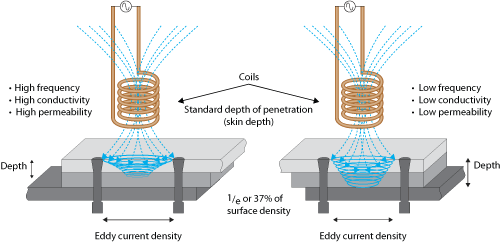Depth of Penetration

Eddy current density does not remain constant across the depth of a material. The density is greatest at the surface and decreases exponentially with depth (the "skin effect"). The standard depth of penetration equation (shown to the right) is used to explain the penetration capability of eddy current testing, which decreases with increasing frequency, conductivity, or permeability. For a material that is both thick and uniform, the standard depth of penetration is the depth at which the eddy current density is 37% of the material surface value. To detect very shallow defects in a material, and also to measure the thickness of thin sheets, very high frequencies are used. Similarly, in order to detect subsurface defects, and to test highly conductive, magnetic, or thick materials, lower frequencies must be used.

Where:
d= Standard depth of penetration (mm)
f= Test frequency (Hz)
mr= Relative magnetic permeability (dimensionless)
s= Electrical conductivity (% IACS)